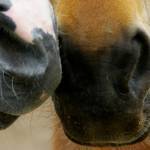Runny Nose: Should You Call the Vet?

A little bit of clear nasal discharge is not uncommon after healthy horses exercise or play energetically. Owners might also see this type of discharge if a horse has been eating hay, and most of the time this runny nose is simply a harmless result of slight irritation from fast breathing or exposure to low levels of dust.
Other types of nasal discharge (heavy, thick, green or yellow, creamy, carrying an unpleasant odor) are more likely to be signs of infection, allergic reaction, or disease. The discharge could be caused by a range of problems: an infected tooth or sinus, a bacterial or viral condition, or even some sort of injury caused by a kick to the face or jaw.
If a nasal discharge is accompanied by an obvious injury or evidence of disease such as an elevated temperature, cough, poor appetite, or swollen lymph nodes, isolate the horse and contact a veterinarian. After handling the horse with the nasal discharge, don’t handle other horses until you have taken precautions to prevent spreading a possible infection to other horses. Wearing gloves, handling sick horses last, and using an alcohol-based hand sanitizer after washing your hands are steps that will minimize the chances of transmitting diseases between horses.
Some infections like strangles are easily spread through nasal secretions. Safety measures to avoid the spread of infection may include using separate buckets, tools, and brushes for the infected horse as well as having handlers change clothes and disinfect shoes after tending to a sick animal.








